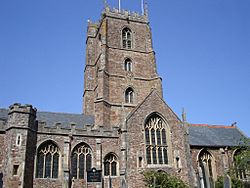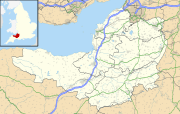Dunster Priory facts for kids
 |
|
| Monastery information | |
|---|---|
| Order | Benedictine |
| Established | c. 1100 |
| Disestablished | 1539 |
| People | |
| Important associated figures | William de Mohun |
| Site | |
| Location | Dunster, Somerset, England |
Dunster Priory was a special religious building called a Benedictine monastery. It was built around the year 1100 in a place called Dunster, in Somerset, England. Monasteries were homes for monks who dedicated their lives to prayer and work.
Contents
The Priory's Beginning
The first church in Dunster was built by a person named William de Mohun. He gave this church, along with money from lands and two fishing spots, to the Benedictine Bath Abbey. Dunster Priory became a smaller part, or "cell," of Bath Abbey.
The church building was used by both the monks and the local people. This often caused arguments! To solve this, a special carved screen was put up. This screen divided the church into two parts. The local people used the western side, and the monks used the eastern side. Today, this church is known as the Priory Church of St George, Dunster. It still has parts from the 12th and 13th centuries, but most of it was built in the 15th century. It is now a "Grade I listed building," which means it's a very important historic building.
Money and Changes Over Time
By the year 1291, Dunster Priory earned money from its lands and rents. It also received money from churches and religious payments. In 1332, the priory became more independent from Bath Abbey. It started to run more on its own. By 1535, the priory's yearly income was about £37.
The Dunster Dovecote
Near the priory, you can find the Dunster Dovecote. This is a round building that is about 19 feet (5.8 meters) tall and 19 feet (5.8 meters) wide. Its walls are about 4 feet (1.2 meters) thick! Inside, there are 540 small holes for birds to nest in. This dovecote used to belong to the priory.
Monks and other people kept Domestic pigeons here. They raised young pigeons, called "squabs," for food. Squabs were a special and expensive meal. For many years, only important people like the Lord of the manor or local priests were allowed to keep pigeons.
The Tithe Barn
The Tithe Barn is another old building from the 14th century. It's also a "Grade II listed building," meaning it's an important historic place. A "tithe" was a payment, usually one-tenth of a person's crops or income, given to the church. This barn was used to store those payments.
The barn has been changed a lot over the years, so only some of its original parts remain. Today, a group called the Somerset Buildings Preservation Trust has worked to fix up the barn. It is now a community hall where people can hold events.
Guest House and Dissolution
In 1346, another monastery called Cleeve Abbey built a nunnery (a home for nuns) in Dunster. However, no nuns ever lived there. Instead, it was used as a guest house for visitors. The former guest house of Dunster Priory, built in the 15th century, is now the Luttrell Arms Hotel.
Dunster Priory was closed down in 1539. This happened as part of the "dissolution of the monasteries," when King Henry VIII closed many monasteries across England.
Burials (in the Priory Church)
Many important people were buried in the priory church, including members of the Mohun and Luttrell families who were powerful in the area:
- John de Mohun, 1st Baron Mohun (1269–1330)
- Sir Hugh Luttrell
- Elizabeth Courtenay, wife of Sir James Luttrell
- Thomas Luttrell (died 1571)
- George Luttrell
- Thomas Luttrell (1583–1644)
- Francis Luttrell (1628–1666)
- Francis Luttrell (1659–1690)
- Alexander Luttrell (1663–1711)
- Henry Fownes Luttrell (died 1780)
- John Fownes Luttrell (1752–1816)


